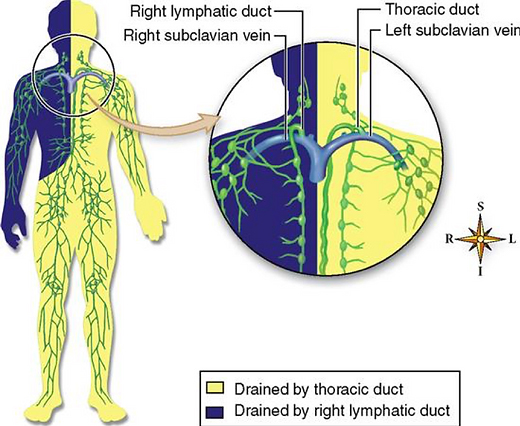A Watershed is an imaginary line that divides the body and the Lymphatic System into quadrants. Each quadrant has its lymphatic liquid collection canal, and the lower quadrants, as per the two legs, sends the liquid to the cisterna kili, a gland that sits deep behind the belly button that is connected to the upper left duct within the upper left quadrant. Some genetic variation, seeing the thoracic duct connecting to the right lymphatic duct.
What does the watershed division look like?
The main watersheds are four.
A vertical one divides the body into two equal vertical halves. A horizontal one divides the body into the upper and lower body at the inguinal level.
Other horizontal watersheds are parallel to each other and are located at:
- The clavicle line
- runs through the belly button
- on top of the iliac crest.
In doing so, we have six quadrants: upper, medial, and lower.
Other watersheds run vertically within the body. Those are located on the arms and on the upper leg.
The importance of watersheds.
As we dig more and more within the functionality of the Lymphatic System and MLD as a Lymphatic Drainage technique, we can see that in these specific quadrants, there are bundles of Lymph nodes that get loaded from the lymph vessels connected to them.
The watershed division allows the liquid to be directed to a specific body area where lymph nodes are found. Indeed, the lymph nodes are the ones that clean up the lymph fluid, also called obligatory lymph load.
When we treat a patient, we have to make sure where we direct the liquid because we want to ensure that the lymph fluid gets sent to the lymph nodes, where it will be processed and then transferred to the lymph/vein duct at the base of the cervical area.
This is extremely important when we treat Lymphoedema, where we may bypass the watersheds, where the lymphatic system has been damaged or is missing, to transport the lymphatic fluid from a stagnant area to an active one.
How to bypass a watershed
To bypass a watershed and transfer the lymphatic fluid from one side of the body to the other side, we have to stimulate the anastomoses, which are the alternative pathways of the lymphatic system.
Unless those pathways are stimulated, we can not transfer the fluid side to side along the horizontal or vertical lines.
An example would be a person who went through a mastectomy and has a unilateral Lymphoedema. In that case, we need to stimulate the upper anastomosis to transfer the fluid side to side. In the drawing beside, you can notice the upper anterior and posterior anatomoses drawn in thick green lines.

The upper watershed and the duct.
After the obligatory lymph load reaches the upper watershed (the one running along the clavicle), it gets passed to the venous system.
This happens after the obligatory lymph load travels with the trunk collector and passes through the duct.
The duct is the last portion of the lymph trunk that connects to the venous system.
In conclusion, we want to specify that the lower quadrants (R leg and L leg) and the upper L quadrant drain in the L thoracic duct within the L subclavian vein.
Where the R upper quadrant drains into the R duct connected to the R subclavian vein.
Below here, is a list of blog posts that talk about conditions where MLD can be beneficial:
Melbourne Massage and Treatment and Lymphatic Drainage Massage
At Melbourne Massage and Treatment, Lymphoedema Clinic, I am specialised in Applied MLD and Lymphoedema management. I did train with the Vodder academy for my Lymphatic Drainage practice, and I have a clinical approach to this type of work.
If you are in need of manual lymphatic drainage treatment, do not hesitate to book your next appointment now. A 15-minute Online free consultation is also available for those who suffer from Lymphoedema or Lipedema.



Pretty! This has been a really wonderful post.
Thank you for providing this info.
Thanks!
I am glad to hear that someone find helpful my Blog post. Especially the one about MLD.